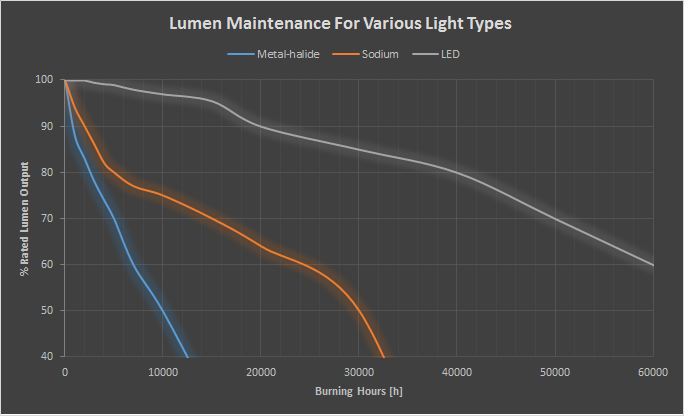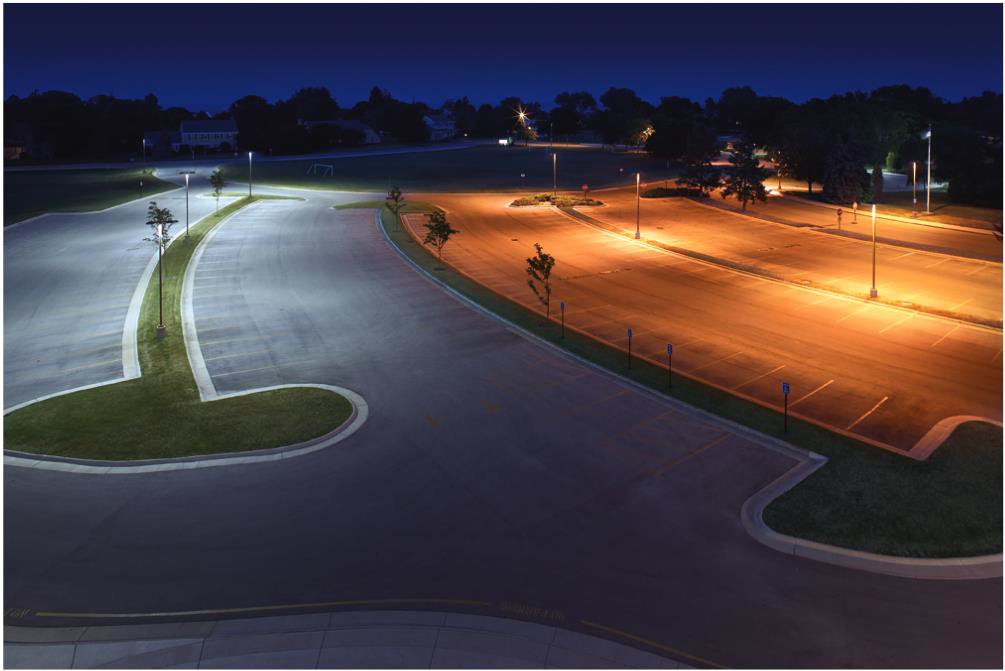Technology and knowledge
LED Technology vs. Traditional lighting
DOCUMENT PREPARED BY GREENIE POLSKA, ON COMPARISON OF LED LIGHTING TECHNOLOGIES WITH MERCURY-VAPOR, SODIUM-VAPOR AND METAL-HALIDE LIGHTING TECHNOLOGIES.Why direct comparison of catalog amount LED lighting lumens and traditional lighting (sodium, mercury, metal halide) lumens does not give reliable results.
Prepared by: Damian Szablak, Tomasz Zwierzchowski
Why direct comparison of catalog amount LED lighting lumens and traditional lighting (sodium, mercury, metal halide) lumens does not give reliable results.
Comparing LED lighting with traditional lighting based on the number of lumens as indicated in product catalogs cannot provide reliable results because the number of lumens that is received by the human eye varies depending on the applied lighting technology. This is due to three factors:
1. Traditional lamps have a narrow spectrum of light, whereas LED lighting has a broad spectrum of light.
2. The standard methodology for evaluating the lumens value does not consider variability of the human eye’s operation, depending on the amount of light that is reached by it.
3. Measurement of luminous flux for traditional lamp covers solely a source of light without lamp fixture and a measurement of LED lamps cover the entire fixture and power supply system.
1. Traditional lamps have a narrow spectrum of light, whereas LED lighting has a broad spectrum of light.
The traditional method of calculating output light power of lamps assumes no light reflection from objects. In reality, however, objects reflect different amounts of light depending on the color of the surface. For example, if you illuminate green object with a yellow light, the whole light beam will be absorbed by the surface of the object and it will look like black. If green object illuminated in such a way is put on the black surface it will be completely invisible. In practice, the reflection of light from the actual objects gives a slightly different effect. For example grass, which looks like green, contains several different pigments (chlorophyll, carotenoids, xanthophylls etc.), thus if it is illuminated by yellow light, it will reflect some of the light rays and will look as if it was gray.
Sodium lamps used in street lighting have narrow light spectrum and, therefore, must have a very high light output, in order to ensure sufficient visibility. LED lighting has a wide spectrum of light, similar to the spectrum of the sun. As a result, differences in the colors of objects are clearer, which results in better contrast and provides better visibility in given area. As a consequence, LED lighting provides better visual acuity with much less number of lumens.

CCT – Color Temperature, CRI – Color Rendering index, LUX – Lighting Intensity, λp – Peak Wave Length
2. The standard methodology for evaluating the lumens value does not consider variability of the human eye’s operation, depending on the amount of light that is reached by it.
Our eyes have two main types of photoreceptors – rods and cones. Cones are sensitive to strong light, they operate in normal conditions (day) and allow color vision (so called “photopic vision”). Rods however, receive light stimuli in adverse conditions (with minimal amount of light). This is so called scotopic vision (when a human sees a world devoid of color, as the cones which are responsible for color recognition are inactive at night vision).
Photometers used to measure light intensity measure only photopic vision. However, in the actual conditions, lighting will be received either by rods and cones (so called “mesopic vision”). In this case, the S / P ratio is helpful, as it allows to convert traditional lumens into lumens that actually are received by the human eye.
S / P is the ratio between the blue-green color and a green-yellow color of light. The larger share of blue-green color, results in higher value of the ratio, and at the same time in better visibility. Light sources with a high S / P ratio provide better visibility at a lower intensity of light.
| Light Source | Watts | Lumens | Lm/W (Photopic Lumens) | S/P Ratio (correction factor) | Pupil Lumens | Pupil lm/W |
| Low Pressure Sodium (LPS) | 250 | 32 500 | 130 | 0,24 | 7 800 | 31 |
| High Pressure Sodium (HPS) | 365 | 37 000 | 101 | 0,62 | 22 940 | 63 |
| Metal Halide (HID) | 200 | 18 000 | 90 | 1,25 | 22 500 | 113 |
| Greenie LED STRADA 120W | 120 | 12 000 |
100 | 2,0 | 24 000 |
200 |
The table shows an example of conversion of traditional lumens into lumens that are actually received by the human eye. LED lighting has a much higher efficiency, which provides better visibility with less energy consumption.
3. Measurement of luminous flux for traditional lamp is covers solely a source of light without a lamp fixture and a measurement of LED lamps cover the entire fixture and power supply system.
Traditional sodium, mercury and metal halide discharge lamps are evaluated based on efficiency of lamp only, at room temperature. This approach does not take into account the impact of the socket in which the lamp is installed. Some sources of LED lighting and high-pressure sodium lamps tend to be very effective (e.g. Their efficiency is up to 100 lumens per watt). But the energy efficiency ratio itself does not show the amount of light which in reality is provided by a light source for a particular purpose.
Lighting efficiency should be measured relatively to the lamp in the fixture. The amount of lumens that actually come to an end target should be measured, not the amount of lumens emitted by a lamp. Lighting efficiency measured in such a way, will always be lower than the lumens that are emitted by the source of illumination. The lower efficiency is a result of the factors that affect the lighting installed in the fixture:
– Trapped light – Traditional lamps emit light in all directions. Such illumination sources need adequate mirrors inside sockets, which are designed to reflect the maximum amount of light rays and direct them to the target. However, it is impossible to effectively re-direct all of the light rays.
– Protective lenses – luminaires usually have lenses that besides the protective function help to focus light rays on the target. The materials, which lenses are built from do not provide 100% of light permeability, and as a consequence the part of the light output is lost.
– Operating Temperature – Multiple light sources has a reduced performance in the event of temperature changes. The source efficiency is measured at 25°C. Whereas the actual operation temperature is significantly different from the temperature of the test, especially for street lighting.
– Power Source – Most light sources have a power supplies, that adjust the input voltage to the voltage used by the lamp. The damage caused by power supply range from 5% to 25%.
Another factor that affects the final performance of lighting and which is very important for comparisons of traditional lighting with LED lighting is a loss of performance over time. Traditional sources of illumination (especially metal halide lamps) are characterized by a significant loss of performance even after a short period of use:
High pressure sodium lamps lose more than 30% efficiency, and their service life is 24 000 hours. Metal halide lamps are losing up to 50% efficiency, and their service life is 6000 – 15 000 hours. LED lighting has a service life of 50 000 – 100 000 hours and loss of productivity of 30% for lighting time of 50 000 hours.
The above comparison clearly shows that LED lighting offers better performance over a much longer period of time than a traditional lighting source, which allows to significantly postpone the need to replace or repair the lighting.
Case study:
In the state of Wisconsin in the United States high – sodium lamps used in the school parking lot, (which gave 19 000 lumens) were replaced for LED lamps providing 8040 lumens. After the change of lighting the car park users were under the impression that the area is much better lightened even though the area was illuminated with fewer lumens.
Left side of parking is illuminated with LED lamps (8040 lumens) and provides better visibility than the area illuminated by high-pressure sodium lamps (19 000 lumens).
1. U.S. Department of Energy – LED Application Series: Outdoor Area Lighting
2. DRK Enterprises – The Perception of Lights and the Ideal Street Light
3. Sigma Luminous – Why You Shouldn’t Compare Lumens between Lighting Technologies
4. Innovative Lighting – LED vs HID Source vs. System Efficiency


